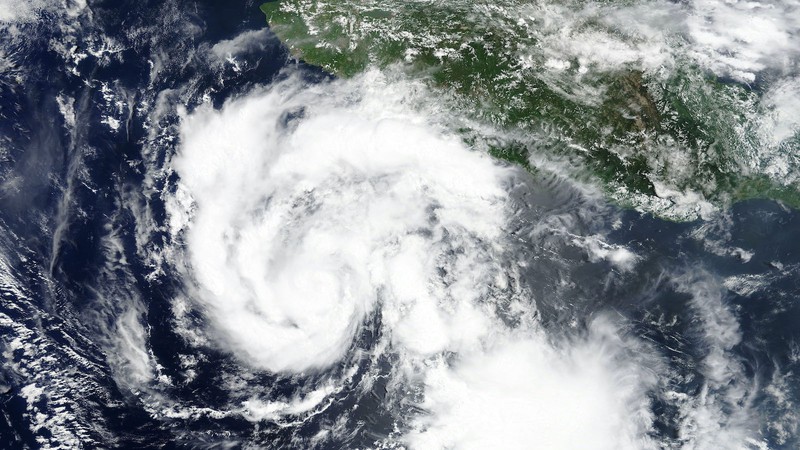Compared to 1939, California has better systems to respond to floods and tropical storms

Hurricane Hilary formed off the coast of Mexico, quickly intensifying from a tropical storm to hurricane status. NASA Goddard Space Flight Center / Wikimedia Commons C.C. 2.0 Generic License
Page One of the Los Angeles Times on Sept. 25, 1939, was for the most part nothing out of the ordinary. There was a report on the death by heart attack at age 72 of Hollywood pioneer Carl Laemmle, co-founder of Universal Studios. The United States was still two years away from entering what soon became World War II, but the Times front page reported on French forces pinning down German troops on the Western Front (the French success wouldn’t last). Another story covered the sinking of a British battleship by a German submarine.
But the big headline told of a genuinely unusual event, maybe one more unusual than Californians at the time realized. The story told of “gales roaring out of the tropics” with 65-mile-per-hour winds that “smashed vessels against piers, breakwaters and beaches” on their way to claiming 29 lives, 24 of them on a capsized fishing boat.
In 1939, California had no statewide agency or mechanism to respond to natural disasters and other emergencies—not even attack by a foreign power.
On a lighter note, a companion story reported that the “howling gale” had finally broken an eight-day heat wave that saw seven days in a row of temperatures topping 100 degrees.
The story of what became known as Hurricane El Cordonazo de San Francisco, or “The Lash of St. Francis” (the official hurricane-naming system was still 14 years away) was extraordinary not only for the tragedies it caused, but for its extreme rarity in California. No hurricane or tropical storm would make landfall in the state again.
Until now.
Hurricane Response, Then and Now
The 1939 tropical storm ultimately killed 45 people on land with its torrential flooding and another 48 in boats at sea. On August 18, 2023, it became clear that 84 years after that disaster, another storm—this one named Hurricane Hilary—was about to slam into the same Southern California coast.
In 1939, however, California had no statewide agency or mechanism to respond to natural disasters and other emergencies—not even attack by a foreign power, even though wars in Europe and Asia appeared certain to pull in the United States soon enough.
The year 2023 appears on track to become the hottest year on record, and ocean waters have heated up as a result.
The state finally remedied that deficiency in 1943, founding the State War Council (though the U.S. had by then been fighting the war on both fronts for two years). At the end of World War II, the War Council, by an act of the legislature, changed its name to the California State Disaster Council and expanded its responsibilities to cover preparation for both war and natural disasters.
In 1970, the “Council” became the Governor’s Office of Emergency Services (Cal OES) which, after a few intervening permutations, is the agency’s name today. From its headquarters in Mather, outside of Sacramento, Cal OES said it was “actively coordinating an early, unified and orderly response across state agencies” to prepare for the rare, incoming tropical storm.
Why Another Hurricane Now?
In all likelihood, Hilary will not be a hurricane when it strikes Southern California. Though it reached Category 4 hurricane status as it remained more than 300 miles off the coast of Cabo San Lucas, Mexico, the storm was expected to ease somewhat, becoming a tropical storm by the time it reached California.
Nonetheless, the imminent arrival of Hilary set off the first tropical storm watch in the history of California. The National Hurricane Center sent out a warning alarmingly headlined “LIFE-THREATENING AND POTENTIALLY CATASTROPHIC FLOODING LIKELY OVER MUCH OF BAJA CALIFORNIA AND SOUTHERN CALIFORNIA.” What happened to bring a tropical storm threat to a state whose usual problem, historically, is not enough rain, rather than too much?
The causes are, of course, complex. But perhaps unsurprisingly one primary reason is climate change. Why? The intensity of hurricanes and tropical storms is largely a function of ocean water temperatures. Warmer water evaporates faster, at the same time that increased heat rises from the ocean’s surface into the atmosphere.
Those phenomena cause storm systems in the upper atmosphere to take on more water in a shorter period of time, leading to heavier rains, stronger winds and, when they reach land, more devastating floods.
The year 2023 appears on track to become the hottest year on record, and ocean waters have heated up as a result. In fact, according to a New York Times report, “Earth’s oceans are the hottest they have been in modern history, by an unusually wide margin.” In Hilary’s case, the storm reached Category 4 only 24 hours after appearing as a tropical storm.
Even with the changing climate, however, ocean waters close to the Southern California coastline remain cool. Currents in that region pull the cold waters of the Northeast Pacific all the way down the coast, resulting in temperatures that typically sit between 55 and 75 degrees. Those cool waters act as a natural shield against the most destructive hurricanes.
Hurricanes in the region have been “rare historically, and it will probably still be pretty rare in the future but maybe somewhat less so,” UCLA climate scientist Daniel Swain told Scientific American. “There’s no way that southern California waters are going to warm high enough to support the development of tropical cyclones.”